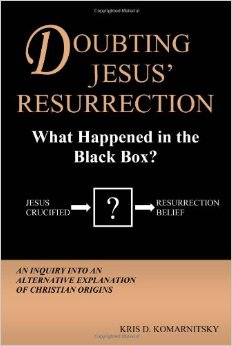By Greg Peterson
 Doubting Jesus' Resurrection: What Happened in the Black Box? (Retails for $21.93 in Paperback)
Doubting Jesus' Resurrection: What Happened in the Black Box? (Retails for $21.93 in Paperback)
“Nothing is esteemed a miracle,” wrote brilliant Scottish philosopher David Hume, “if it ever happen in the common course of nature. It is no miracle that a man, seemingly in good health, should die on a sudden: because such a kind of death, though more unusual than any other, has yet been frequently observed to happen. But it is a miracle, that a dead man should come to life; because that has never been observed in any age or country.”
.Without making direct reference to Hume, Kris Komarnitsky in “Doubting Jesus’ Resurrection: What Happened in the Black Box?” takes up the challenge of explaining the one case that many people DO consider to have been an observed instance of a dead man coming to life, in naturalistic terms. He succeeds, I think, because he keeps his aim comparatively modest: to present a plausible case for Christian origins absent a supernatural miracle. Other authors taking on a similar challenge have tried to explain every element of the Gospel passion story with reference to mystery cults and syncretism, or cabals and conspiracies, or pure fraud and gullibility. In aiming only to provide an alternative hypothesis for the resurrection story, and by being reasonable and kind—even generous—to believers, Komarnitsky comes off cogent and sane. It is noteworthy, perhaps, that he is not even an atheist, as he points out several times in the book, but is agnostic on the question of a god’s existence. This book, then, is a matter of pure inquiry, and stands up well to scholarly scrutiny.
This is perhaps all the more remarkable because Komarnitsky, while certainly scholarly, is not technically an historian or Bible scholar, and makes much of his argument by digesting an impressive array of primary and secondary sources, to which he brings an open but critical mind. As a former biblical studies major and life-long Bible enthusiast, I have read the works of many of the top scholars in the field, and Komarnitsky compares favorably with the elites. I was reminded of the scene in the Wizard of Oz when the wizard told the scarecrow that he was as smart as any scholar, and lacked only official credentials. At the risk of your picturing Komarnitsky stuffed with straw, here is such a scholar, as learned and intelligent as any credentialed author I’ve encountered.
Late in the book, after having made a compelling case, Komarnitsky writes, “Christianity and other religions may bring enormous good to the world, but if this book is correct that Jesus did not resurrect from the dead, then many people have a false understanding of the world. False understandings have a way of leading to unfavorable consequences over the long term.” I could not have said it better, or agree more. And Christianity itself makes great claims for valuing truth, so believers should feel welcome to examine the evidence that “Doubting” adduces, and test where the truth might best lie.
While it is said of theories in physics that the best ones can become T-shirt slogans, “Doubting” requires a bit more space than that for its hypothesis. Yet Chapter 6 of the book, two pages long, presents the case in an easily graspable and memorable format. It is the mark of a well-thought-out idea that it can be expressed so succinctly and still carry force. If I have a complaint about the book, it is that sometimes the supporting material goes beyond what it must to make its point—but that is a common fault in scholarly works. And some people—the more critical readers, perhaps (I already accepted much of what was in the book before even picking it up!) will want that extra material and additional references to dig deeper and become more convinced.
I will not lay out the specific case made in “Doubting”—you really should read this book if you’re interested. But I will quote the sentence from the book that, for me, sums up its power of persuasion: “In the plausibility test, the best explanation is the one that is the most probable when measured against accepted truths outside of the question of interest.” It is this attitude that reminds me of Hume’s view, and which puts Komarnitsky in the best tradition of graceful skepticism.

